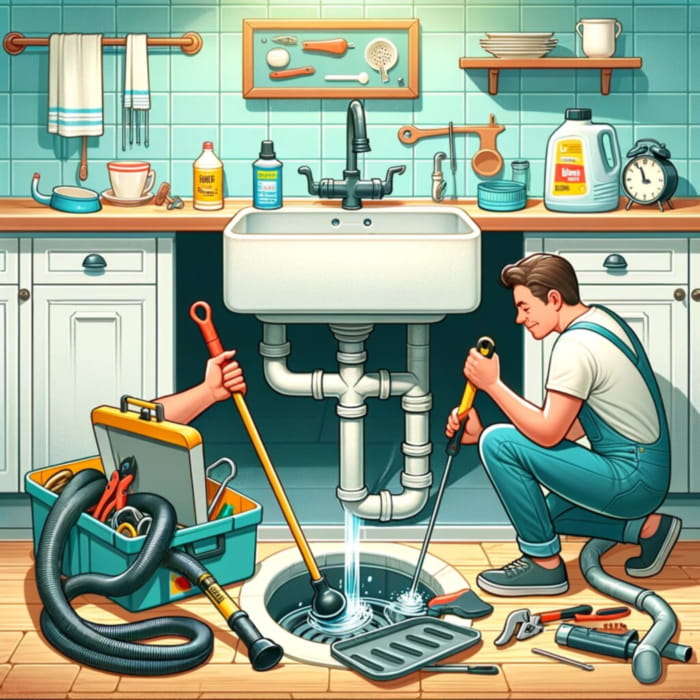Dealing with a blocked drain can be stressful, especially when unsure who’s responsible for fixing it and what steps to take. This comprehensive guide, tailored specifically for the UK, aims to alleviate your worries and equip you with the knowledge to tackle blocked drains confidently. Whether it’s a stubborn blockage in your sink or a sewage issue affecting your entire property, we’ll navigate you through the process, from identifying the culprit to finding help and getting things flowing smoothly again.
Who is responsible for repairing drains and sewers?
Dealing with a blocked drain can be confusing, especially when it comes to figuring out who shoulders the responsibility for repairs. In the UK, things can get a bit tricky as the answer depends on two factors: where the blockage is located and who owns the drain or sewer.
Here’s a breakdown to help you navigate the responsibility maze:
Inside Your Property (Private Drains):
-
- You are responsible for repairing and maintaining all drains and pipes within your property boundaries. This includes drains from sinks, toilets, baths, washing machines, and dishwashers.
-
- If the blockage lies within your private drains, you’ll have to pay for the repairs. You can either choose to fix it yourself or hire a qualified plumber.
Outside Your Property:
-
- Public Sewers: The responsibility shifts to your local water company. Public sewers collect wastewater from multiple properties and are maintained by water companies. If the blockage occurs within the public sewer, your water company is responsible for fixing it at no cost to you.
-
- Lateral Drains: These connect your private drains to the public sewer. They usually run under your property and sometimes shared with neighbouring properties. The responsibility here depends:
-
- If your property is the only one connected to the lateral drain: You are responsible for repairs and costs.
-
- If multiple properties share the lateral drain: Everyone sharing the drain shares the responsibility and costs for repairs. Your water company can help determine this.
-
- Lateral Drains: These connect your private drains to the public sewer. They usually run under your property and sometimes shared with neighbouring properties. The responsibility here depends:
- Private Sewers: In rare cases, some properties might have private sewers instead of connecting to the public system. If you have a private sewer, you are completely responsible for its maintenance and repairs.
What’s the difference between a drain and a sewer?
A drain and a sewer are both parts of a wastewater system, but they perform different functions. A drain is a pipe that transports water or sewage from a single property into the larger sewer system. Meanwhile, a sewer is a network of underground pipes that collects and carries the waste from multiple properties to treatment facilities.
What are the signs of a blocked drain?
Signs of a blocked drain can include a foul odour emanating from the drain, slow draining water, and gurgling noises after running water. Other indications can be pools of water forming around drains or an overflow of water. In severe cases, toilets and sinks may not drain, indicating a serious blockage.
Repair and Costs in the UK: Understanding Your Options for Drain Repairs and Potential Costs Involved
In the UK, dealing with blocked drains and sewers involves understanding the various repair options available and the associated costs. This section provides an overview of both DIY and professional repair methods, along with typical costs you might expect in the UK market. Whether you’re a homeowner or a landlord, being aware of these options can help you make informed decisions.
DIY Repair Options
- Manual Methods:
Plunging: A cost-effective and simple method for minor blockages. A standard plunger typically costs between £5 and £15.
Drain Snakes/Augers: Effective for more stubborn blockages. A basic manual drain snake costs around £10 to £40.
- Chemical Drain Cleaners:
Useful for dissolving organic material. Prices vary, but most are under £20 per bottle. Use cautiously to avoid pipe damage.
- High-Pressure Drain Cleaners:
More effective for tough blockages. Renting a high-pressure cleaner can cost about £30 to £70 per day.
Professional Repair Services
- Standard Drain Cleaning:
Prices typically range from £60 to £200, varying based on blockage severity and location.
- CCTV Drain Surveys:
Necessary to diagnose complex problems. Costs for these surveys can range from £90 to £350.
- Sewer Line Repair:
More extensive repairs can be costly, ranging from £400 to several thousand pounds, depending on the repair’s nature.
- Emergency Call-Out Fees:
For urgent issues, expect higher charges, which can be about 50% more than standard rates.
Additional Considerations
- Regular Maintenance:
Scheduled maintenance can prevent severe blockages, reducing the need for expensive repairs.
- Insurance:
Some home insurance policies in the UK cover sewer and drain issues. Check your policy for specifics.
- Local Council Services:
Some local councils offer services for blocked drains, which can be a cost-effective solution, especially for issues on public land.
How do you unblock a block drain?
Unblocking a blocked drain can seem like a daunting task, especially if it’s your first time tackling such an issue. However, with the right approach and tools, turning this challenge into a manageable DIY project is entirely feasible. Here’s how to approach the task:
Step 1: Identify the Location of the Blockage
The first step in unblocking a drain is to pinpoint the blockage’s location. It could be in the pipes beneath your sink or bathtub, or it might be further along in your plumbing system. You can often determine the blockage’s location by observing which drains are backing up and how quickly water drains.
Step 2: Use a Plunger
Once you’ve located the blockage, a common and straightforward method to attempt first is using a plunger. You’ll need a sink or toilet plunger, depending on the type of drain. Ensure there’s enough water in the sink or tub to cover the plunger’s base. Place the plunger over the drain and use forceful, consistent plunges to try and dislodge the blockage.
Step 3: Try a Plumber’s Snake or Hand Auger
If the plunger doesn’t do the trick, your next tool could be a plumber’s snake or hand auger. This tool can reach further into the plumbing to dislodge the blockage. Insert the snake into the drainpipe and turn the handle to break up the blockage. Be sure to follow the manufacturer’s instructions to avoid damaging your pipes.
Step 4: Consider a High-Pressure Drain Blaster
For more stubborn blockages, a high-pressure drain blaster might be necessary. This tool uses pressurized water to clear blockages but should be used cautiously to prevent damage to your plumbing.
Step 5: Use Drain Cleaning Chemicals as a Last Resort
If all else fails, you might consider a drain cleaning chemical. However, these should be used sparingly, as they can corrode pipes and harm the environment. They should be a last resort.
Prevention and Professional Help
It’s crucial to address blockages as soon as they are noticed. Untreated blockages can lead to significant damage and more costly repairs down the line. If you’ve made several attempts to unblock the drain without success, or if the blockage is a recurring issue, it might be time to call in a professional plumber. They have specialized tools and expertise to deal with stubborn blockages effectively and safely.
What is the best homemade drain cleaner?
One of the best homemade drain cleaners involves a mixture of baking soda and vinegar. This eco-friendly solution is simple to make and involves pouring half a cup of baking soda into the drain, followed by half a cup of vinegar. After 20 minutes, flush with boiling water for a clean, unclogged drain.
How can I prevent blockages?
To prevent blockages, regular maintenance is crucial. You can avoid pipe clogs by not disposing off oil and hard food wastes down the drains. Regularly clean showers and sinks to remove hair and soap particles. For blood vessels, maintain a healthy diet and lifestyle to prevent cholesterol buildup, thus avoiding blockages.
Remember:
- Prevention is key: Proper waste disposal and regular drain maintenance can significantly reduce blockages.
- Don’t flush anything but the “three Ps”: Pee, poo, and (toilet) paper. Other materials can clog drains.
- Act quickly: Addressing blockages early prevents overflows and potential damage.
- Seek professional help when needed: Don’t hesitate to call a plumber for complex blockages or sewer issues.
- Utilize available resources: Water companies and local councils offer valuable help and support.
By following these insights and utilizing the resources provided, you’ll be well-equipped to handle blocked drain situations confidently and efficiently. Remember, a little knowledge goes a long way in keeping your drains flowing freely and preventing unnecessary stress. If you’re still unsure about your specific situation, please call your local water company or a qualified plumber for further assistance.


